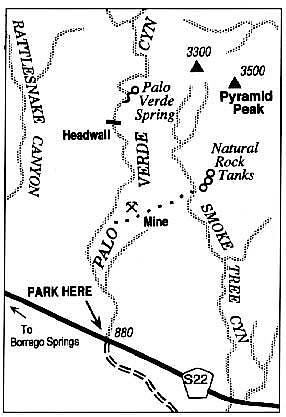 Facebook
Facebook
 X
X
 Instagram
Instagram
 TikTok
TikTok
 Youtube
Youtube
With midday temperatures declining into the 80s this month and next, the vast spaces of the Anza-Borrego Desert are again becoming attractive places to explore. For the following hike up Palo Verde Canyon in the southern reaches of the Santa Rosa Mountains, wear hiking boots to keep cactus spines at bay, and carry two quarts of water (on a warm day) to quench your thirst. Even though the sun has retreated quite far south by now, sun-shielding clothing is still a good idea.
This hike originates along County Highway S-22 (Borrego-Salton Seaway), approximately 18 miles east of Borrego Springs. Park where you can well off of the pavement at mile 32.9 (according to the green mile-markers spaced each mile along the highway). Remember that you'll need a state park permit ($5 per day, or $50 yearly) for parking here and anywhere else within Anza-Borrego Desert State Park. Permits are available at park headquarters and at the Anza-Borrego Visitors' Center in Borrego Springs and at widely scattered, clearly marked roadside spots throughout the park.
At mile 32.9, there's a dip where the highway crosses a dry riverbed. This is Palo Verde Wash, named for the palo verde trees that dot its course. On foot, follow this wash generally north (gradually uphill) toward a prominent cut in the mountains ahead -- Palo Verde Canyon. The wash is "braided," consisting of multiple channels cut during past flash floods. Keep close to the middle of the drainage to stay on course.
After 1.3 miles, the canyon walls begin to close in on both sides and travel slows a bit as you're forced to step over more and bigger rocks. (In another 0.2 mile you may spot an obscure trail going up the steep slope to the right. A side trip on this -- an old miner's trail -- would lead you to an old mine tunnel sunk deeply into a prominent vein.)
Progress up Palo Verde Canyon ends after a total of three miles, at which point you'll find yourself in the bottom of a bowl flanked on three sides by sheer walls soaring over 400 feet high. Infrequent flash floods tear through here, probably creating for a brief interval of time a terrific waterfall.


With midday temperatures declining into the 80s this month and next, the vast spaces of the Anza-Borrego Desert are again becoming attractive places to explore. For the following hike up Palo Verde Canyon in the southern reaches of the Santa Rosa Mountains, wear hiking boots to keep cactus spines at bay, and carry two quarts of water (on a warm day) to quench your thirst. Even though the sun has retreated quite far south by now, sun-shielding clothing is still a good idea.
This hike originates along County Highway S-22 (Borrego-Salton Seaway), approximately 18 miles east of Borrego Springs. Park where you can well off of the pavement at mile 32.9 (according to the green mile-markers spaced each mile along the highway). Remember that you'll need a state park permit ($5 per day, or $50 yearly) for parking here and anywhere else within Anza-Borrego Desert State Park. Permits are available at park headquarters and at the Anza-Borrego Visitors' Center in Borrego Springs and at widely scattered, clearly marked roadside spots throughout the park.
At mile 32.9, there's a dip where the highway crosses a dry riverbed. This is Palo Verde Wash, named for the palo verde trees that dot its course. On foot, follow this wash generally north (gradually uphill) toward a prominent cut in the mountains ahead -- Palo Verde Canyon. The wash is "braided," consisting of multiple channels cut during past flash floods. Keep close to the middle of the drainage to stay on course.
After 1.3 miles, the canyon walls begin to close in on both sides and travel slows a bit as you're forced to step over more and bigger rocks. (In another 0.2 mile you may spot an obscure trail going up the steep slope to the right. A side trip on this -- an old miner's trail -- would lead you to an old mine tunnel sunk deeply into a prominent vein.)
Progress up Palo Verde Canyon ends after a total of three miles, at which point you'll find yourself in the bottom of a bowl flanked on three sides by sheer walls soaring over 400 feet high. Infrequent flash floods tear through here, probably creating for a brief interval of time a terrific waterfall.
